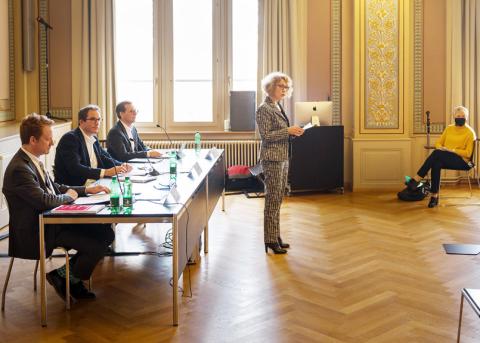Emil G. Bührle Collection: Through the Gates of Hell into the Kunsthaus Zürich
It’s one of the most famous works of art in the city of Zurich: Auguste Rodin’s shiny black “Gates of Hell”. Standing a good six meters high atop a pedestal, it is located right next to the main entrance of Kunsthaus Zürich. Lesser known is the history behind this impressive sculpture on public display. In 1942, Hitler’s art expert, Hermann Göring, commissioned this cast of the “Gates of Hell” for the planned “Führermuseum” (Leader’s Museum) in Linz, Austria. Shortly before the completion of the bronze sculpture, the Nazis had lost the war and the “Gates of Hell” landed with the Allies, who sold it to the Swiss arms manufacturer, Emil G. Bührle. During the war, Bührle had sold cannons to the Nazis, laying the foundation for his fortune, which he invested to a large extent in art. In 1947, he bequeathed the sculpture to Kunsthaus Zürich.
Turning your back on the martyred bodies of Rodin’s vision of hell, you can look over to the pompous gilded entrance of the Kunsthaus extension, nearing completion, designed by star architect David Chipperfield – where Bührle’s collection is soon to find a new home. The “Gates of Hell” is exemplary of the historical entanglements of Bührle’s art collection. At the same time, the work symbolizes Zurich’s rather carefree handling of the historically contentious collection.
After all, a study was commissioned well before the opening of the 206-million-franc extension, which was substantially financed with public money. Two historians were tasked with exposing the invisible history of the Bührle Collection in a report that would be “scientifically substantiated and independent.” As WOZ has made public, some of their findings were removed from the report by the contractors and project manager. The accusation of whitewashing is in the air. But these grave incidents are not the only problem in Zurich’s approach to the collection.
A thorough analysis of the complex Bührle history cannot be gained through traditional provenance research that looks only at the artworks which were looted or forced to be left behind. According to the French art historian, Bénédicte Savoy, we should deal more fundamentally with the expropriation and displacement of cultural assets “against the backdrop of the great wars of the 20th century.” In this case it would mean showing how the Kunsthaus itself, whose value is clearly enhanced by the collection, is enmeshed in this world history. Such questions, which were envisaged in the original study concept, would have made it possible to reevaluate the collection and the role of the Kunsthaus – but they are threatening to be swept under the table once again.
To this day, there has been practically no public debate on the Bührle case in Switzerland – something that would hardly be conceivable in an international context. In the USA, for example, the art patronage of the Sackler pharmaceutical family, which is considered to be the main culprit in the opioid crisis there, has triggered ongoing protests – and museums have had to draw the consequences.
Swiss newspapers have praised Chipperfield’s architecture and the added value it brings to Zurich as an art location. But barely a sentence has been uttered about the origins of the collector’s fortune, whose treasures will “enrich the Kunsthaus in the most beautiful way,” as enthused in the “Tages-Anzeiger” newspaper. This is entirely in the accommodating spirit of contemporary location marketing, which obscures war and death as sources of profit, all for the sake of a polished image.
The fact is, the art for which this bombastic structure, worth millions, was built with tax money, and which aims to enrich our cultural life, was acquired with money from the arms trade. Zurich’s beloved “Gates of Hell” once belonged to Hitler himself. While this poses no legal issues, it does raise ethical questions about the business that went over dead bodies to make this collection possible. It’s time we started talking seriously about it, in this rich, bustling city. Preferably on the basis of a new, honest, and truly independent study.
Translated by Alisa Kotmair.
See also “Bührle History is Whitewashed” , “Rectifying Emil G. Bührle’s complex legacy” and “A Cézanne in the Turmoil of the Second World War” .

